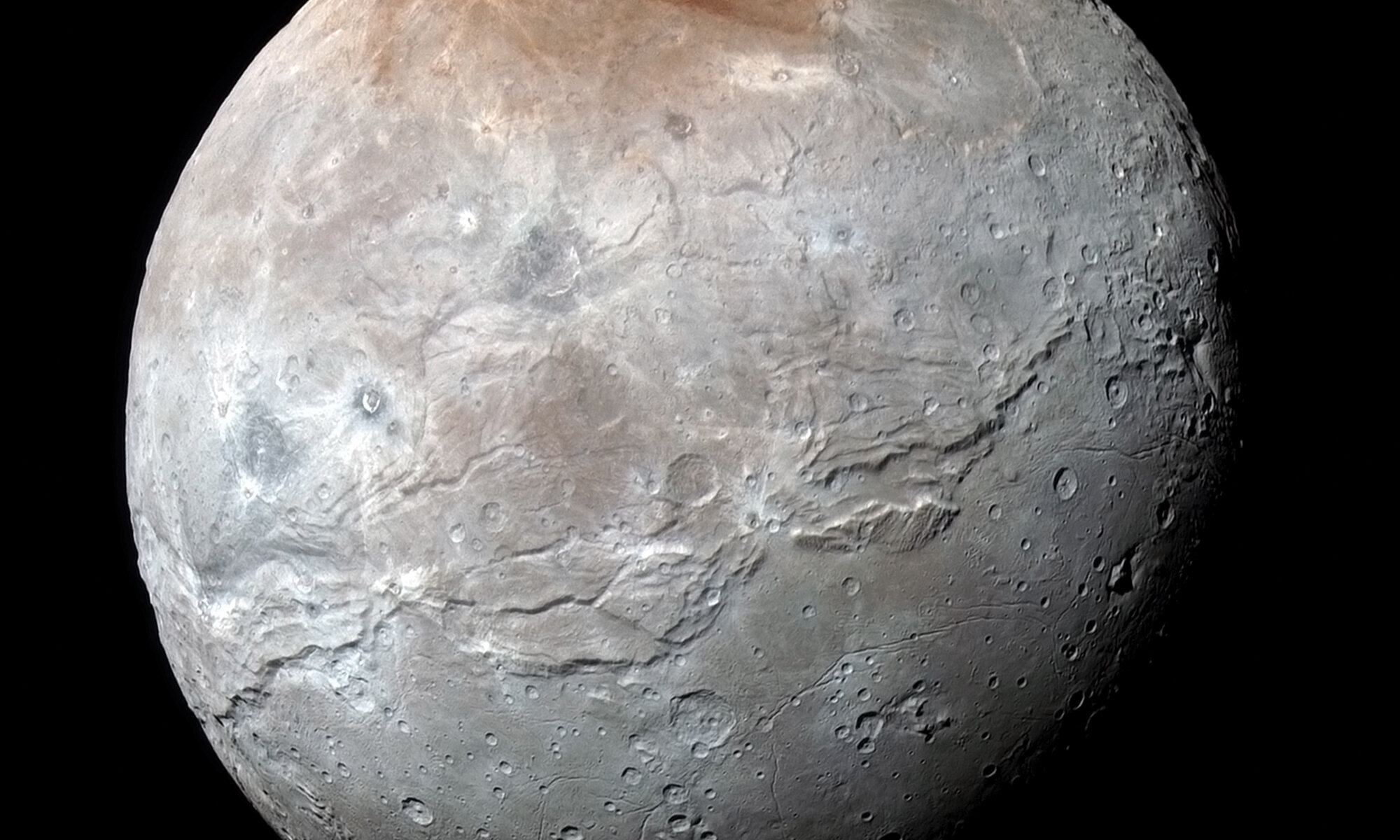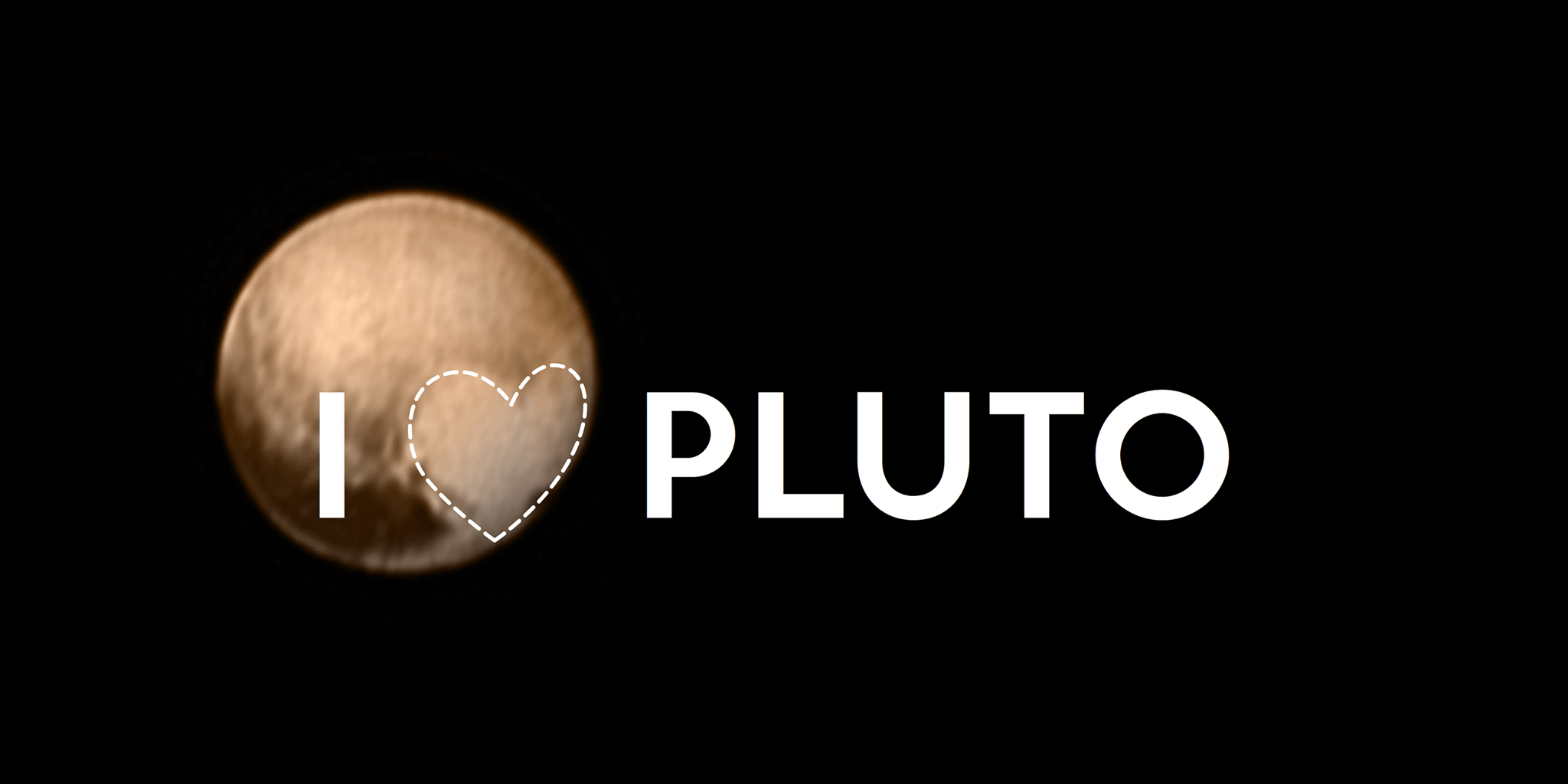Pluto’s largest moon, Charon, started off as a beautiful, smooth red grape until someone came along, mostly peeled it, tried to smoosh it, then just gave up and walked away, leaving the poor moon to look like the absolute travesty that it is. Okay, so maybe that’s not exactly what happened, but Charon just looks like a mess and scientists want to know why. Never mind its smooshed equator, but what’s the deal with its red cap? Where did it come from and why is it red?
Continue reading “Charon’s Red Cap at its North Pole? We Might Have an Answer”Charon Suffered Surprisingly Titanic Upheavals in Fresh Imagery from New Horizons
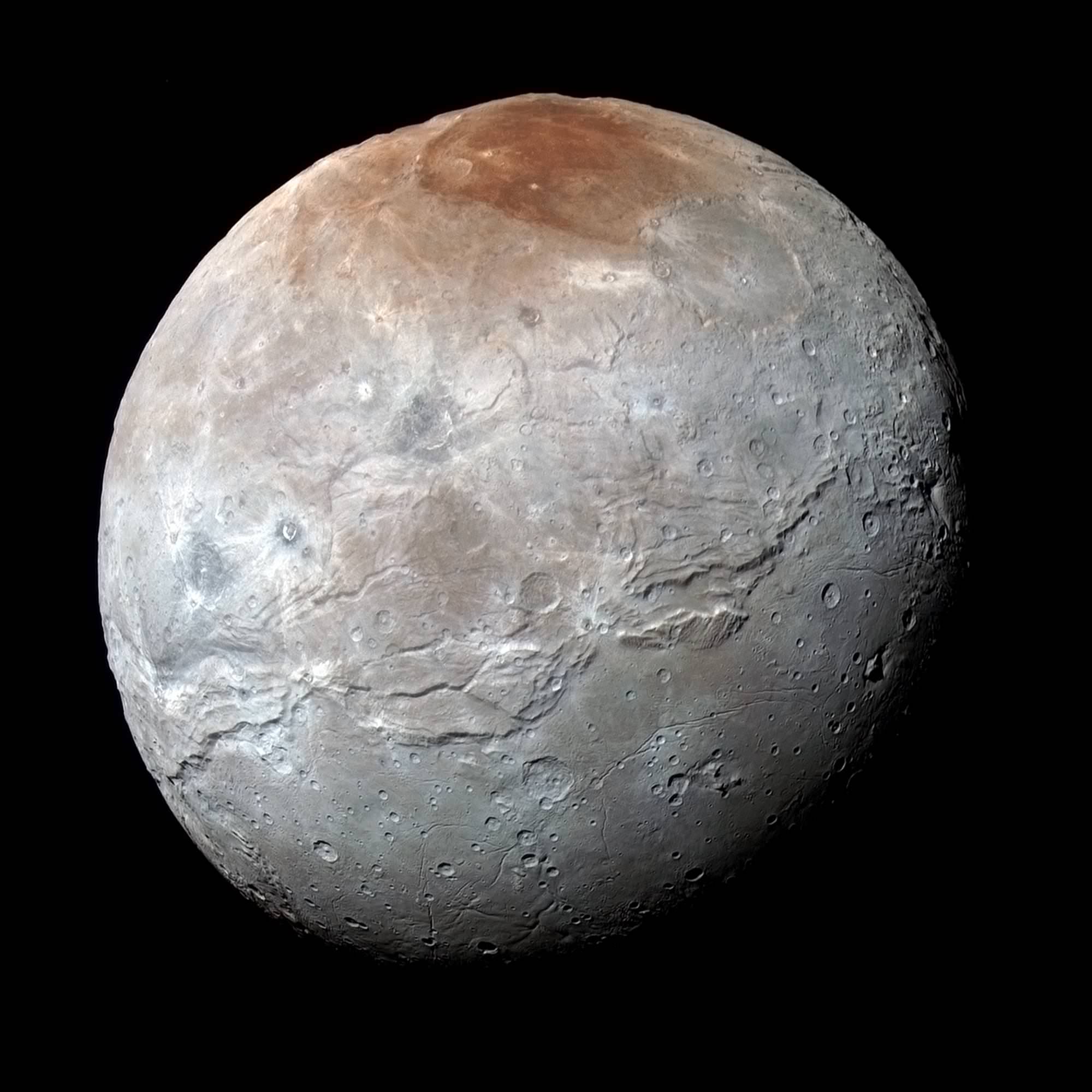
Charon in Enhanced Color with Grand Canyon
NASA’s New Horizons captured this high-resolution enhanced color view of Charon and its Grand Canyon just before closest approach on July 14, 2015. The image combines blue, red and infrared images taken by the spacecraft’s Ralph/Multispectral Visual Imaging Camera (MVIC); the colors are processed to best highlight the variation of surface properties across Charon. Charon’s color palette is not as diverse as Pluto’s; most striking is the reddish north (top) polar region, informally named Mordor Macula. Charon is 754 miles (1,214 kilometers) across; this image resolves details as small as 1.8 miles (2.9 kilometers). Credits: NASA/JHUAPL/SwRI[/caption]
Charon suffered such a surprisingly violent past of titanic upheavals that they created a humongous canyon stretching across the entire face of Pluto’s largest moon – as revealed in a fresh batch of images just returned from NASA’s New Horizons spacecraft.
We have been agog in amazement these past few weeks as New Horizons focused its attention on transmitting astounding high resolution imagery and data of Pluto, captured during mankind’s history making first encounter with our solar systems last unexplored planet on July 14, 2015, at a distance of 7,750 miles (12,500 kilometers).
Now after tantalizing hints we see that Charon, Pluto’s largest moon, did
not disappoint and is no less exciting than the “snakeskin texture mountains” of Pluto revealed only last week.
“You’ll love this,” said New Horizons Principal Investigator Alan Stern of the Southwest Research Institute, Boulder, Colorado, in a blog posting.
Indeed researches say Charon’s tortured landscape of otherworldly canyons, mountains and more far exceeds scientists preconceived notions of a “monotonous, crater-battered world; instead, they’re finding a landscape covered with mountains, canyons, landslides, surface-color variations and more.”
“We thought the probability of seeing such interesting features on this satellite of a world at the far edge of our solar system was low,” said Ross Beyer, an affiliate of the New Horizons Geology, Geophysics and Imaging (GGI) team from the SETI Institute and NASA Ames Research Center in Mountain View, California, in a statement.
“But I couldn’t be more delighted with what we see.”
Measuring 754 miles (1,214 kilometers) across, Charon is half the diameter of Pluto and forms a double planet system. Charon also ranks as the largest satellite relative to its planet in the solar system. By comparison, Earth’s moon is one quarter the size of our home planet.
The new images of the Pluto-facing hemisphere of Charon were taken by New Horizons’ Long Range Reconnaissance Imager (LORRI) and the Ralph/Multispectral Visual Imaging Camera (MVIC) during the July 14 flyby and downlinked over about the past week and a half.
They reveal details of a belt of fractures and canyons just north of the moon’s equator.
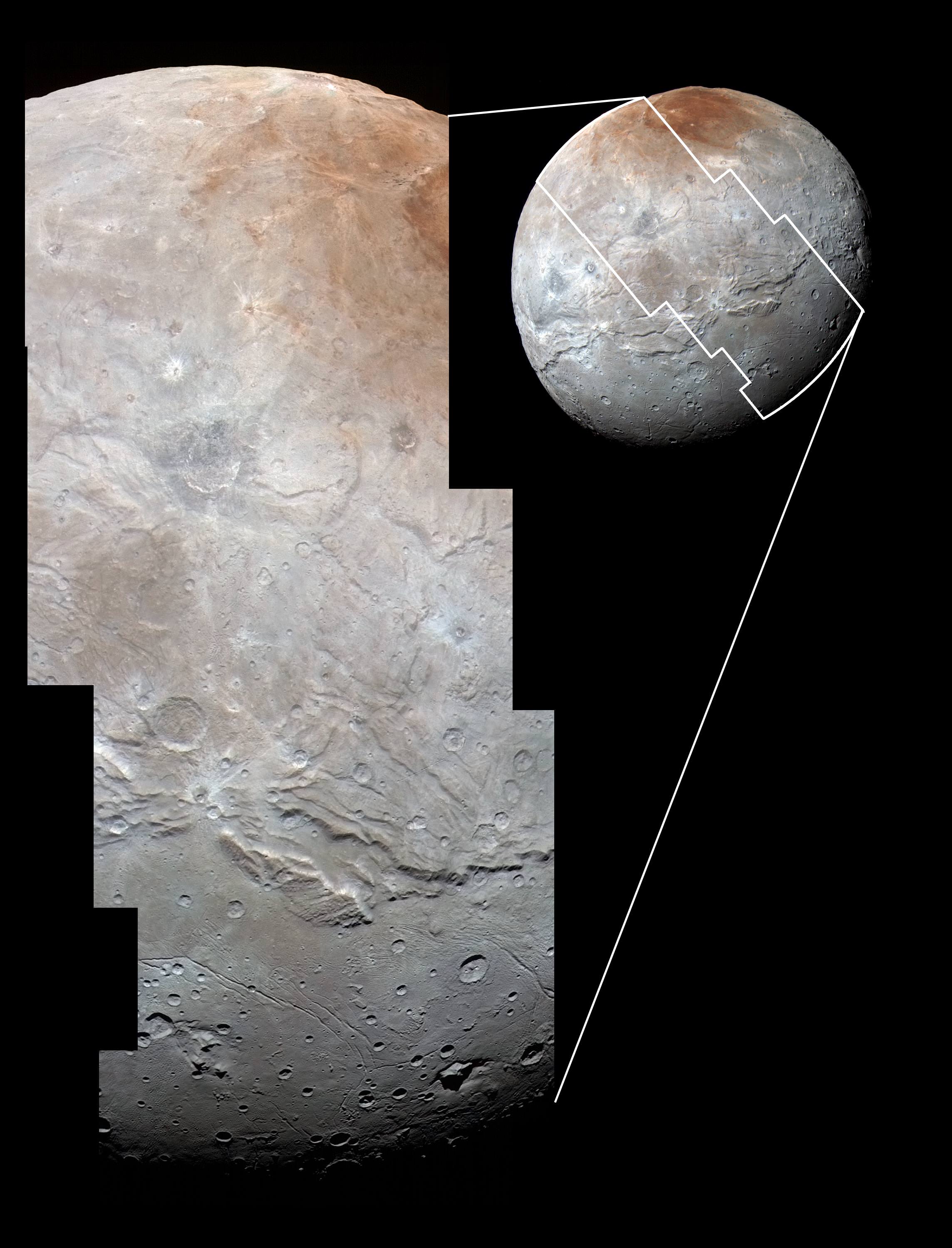
The “Grand Canyon of Charon” stretches more than 1,000 miles (1,600 kilometers) across the entire face of Charon visible in the new images. Furthermore the deep canyon probably extends onto the far side of Pluto and hearkens back to Valles Marineris on Mars.
“It looks like the entire crust of Charon has been split open,” said John Spencer, deputy lead for GGI at the Southwest Research Institute in Boulder, Colorado, in a statement.
“With respect to its size relative to Charon, this feature is much like the vast Valles Marineris canyon system on Mars.”
Charon’s “Grand Canyon” is four times as long as the Grand Canyon of the United States. Plus its twice as deep in places. “These faults and canyons indicate a titanic geological upheaval in Charon’s past,” according to the New Horizons team.

Another intriguing finding is the area south of the canyon is much smoother, with fewer craters and may have been resurfaced by a type of “cryovolcanism.”
The southern plains are informally named “Vulcan Planum” and may be much younger.
“The team is discussing the possibility that an internal water ocean could have frozen long ago, and the resulting volume change could have led to Charon cracking open, allowing water-based lavas to reach the surface at that time,” said Paul Schenk, a New Horizons team member from the Lunar and Planetary Institute in Houston.
The piano shaped probe gathered about 50 gigabits of data as it hurtled past Pluto, its largest moon Charon and four smaller moons.
Barely 5 or 6 percent of the 50 gigabits of data captured by New Horizons has been received by ground stations back on Earth due to the slow downlink rate.
Stern says it will take about a year for all the data to get back. Many astounding discoveries await.
“I predict Charon’s story will become even more amazing!” said mission Project Scientist Hal Weaver, of the Johns Hopkins University Applied Physics Laboratory in Laurel, Maryland.
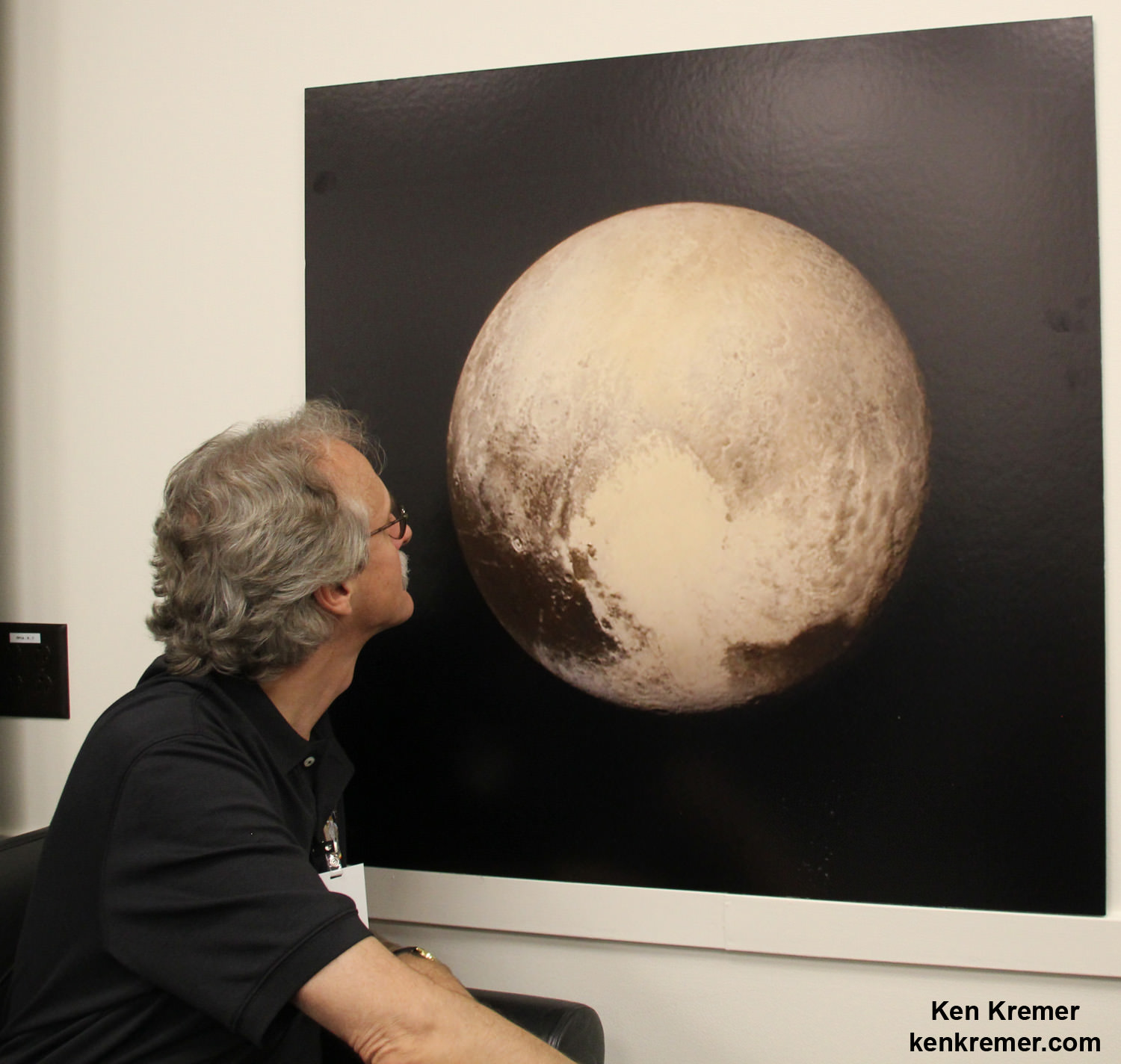
Stay tuned here for Ken’s continuing Earth and planetary science and human spaceflight news.
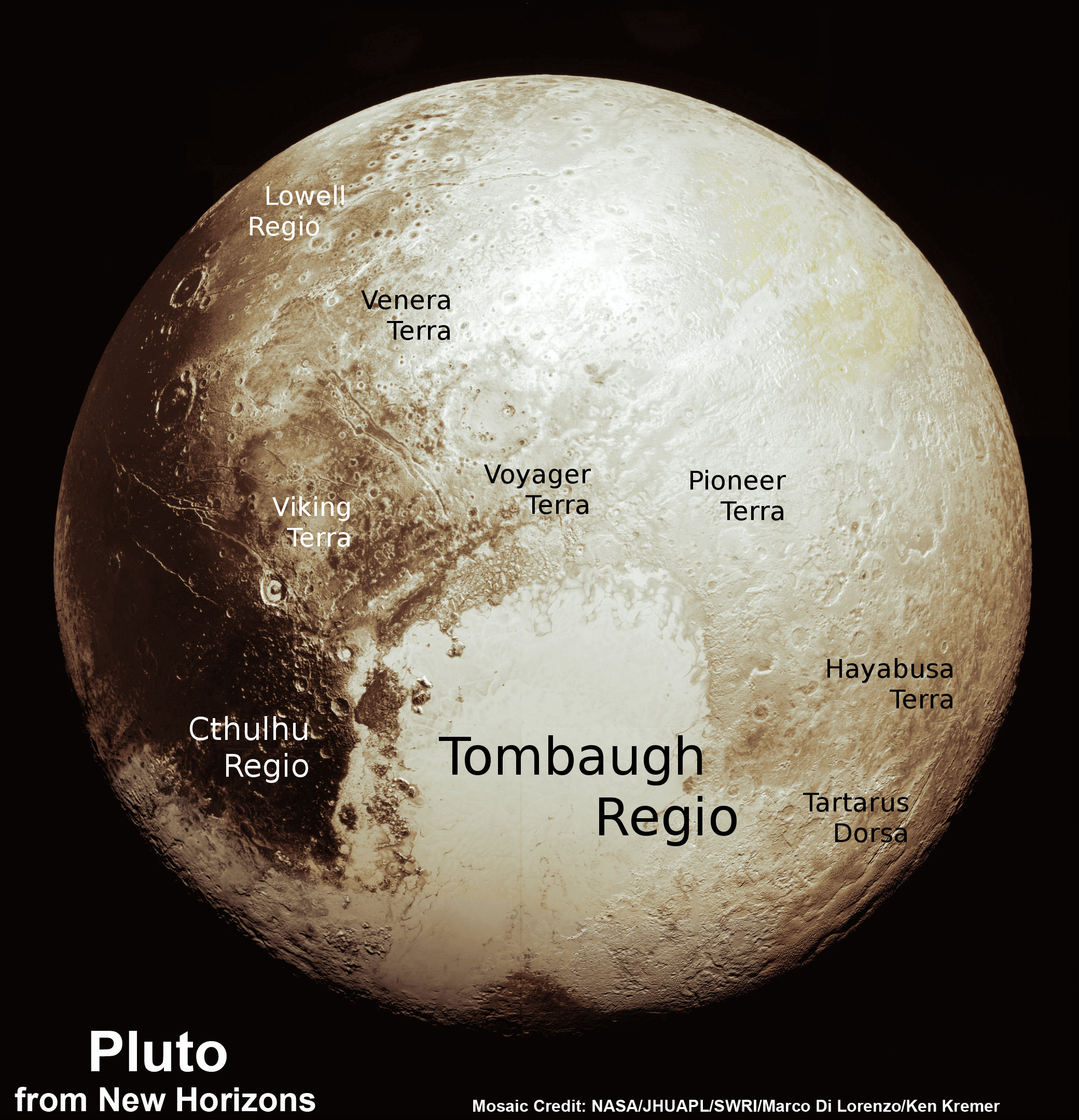
Mysterious Mountain Revealed in First Close-up of Pluto’s Moon Charon
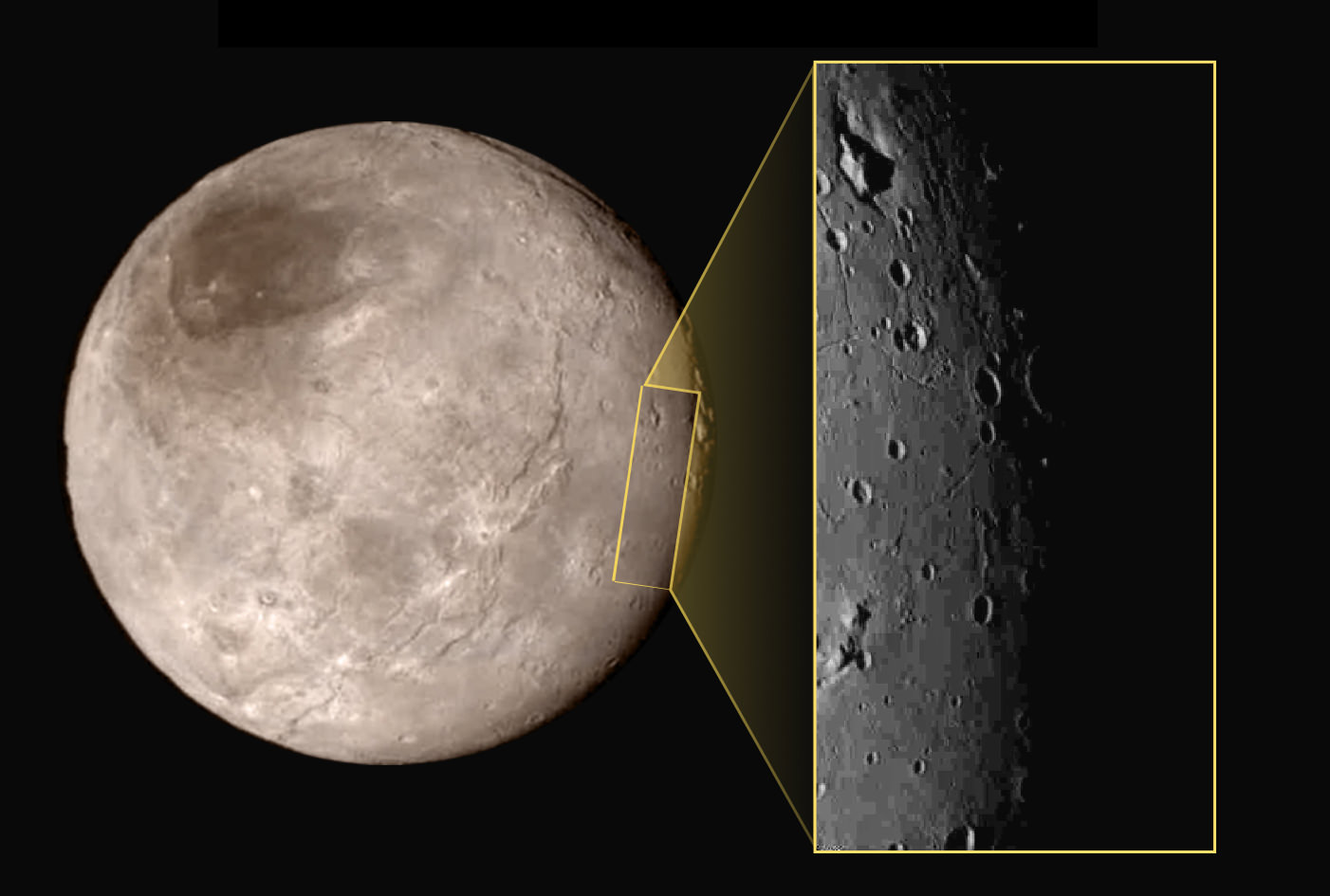
This new image of an area on Pluto’s largest moon Charon has a captivating feature — a depression with a peak in the middle, shown here in the upper left corner of the inset. The image shows an area approximately 240 miles (390 kilometers) from top to bottom, including few visible craters. The image was taken at approximately 6:30 a.m. EDT on July 14, 2015, about 1.5 hours before closest approach to Pluto, from a range of 49,000 miles (79,000 kilometers). Credits: NASA-JHUAPL-SwRI
Story updated[/caption]
APPLIED PHYSICS LABORATORY, LAUREL, MD – A mysterious mountain in the middle of a moat on Pluto’s biggest moon Charon, has captivated and baffled scientists leading NASA’s New Horizons mission which made history when it became the first spacecraft to visit our solar system’s most distant planet barely two days ago on Tuesday morning, July 14, 2015.
NASA released the first close-up image of Charon today (July 16), shown above, and it has the geology team scratching their heads in amazement and wonder. They can’t figure out the nature of a big mountain set inside a moat.
The new image shows a depression with a mountain peak in the middle.
“The most intriguing feature is a large mountain sitting in a moat,” said Jeff Moore with NASA’s Ames Research Center, Moffett Field, California, who leads New Horizons’ Geology, Geophysics and Imaging team. “This is a feature that has geologists stunned and stumped.”
The location of the “mountain in a moat” is shown in the inset of a global view of Charon.
The new high resolution image of Charon was taken at approximately 6:30 a.m. EDT (10:30 UTC), barely an hour and a half before the piano-shaped spacecraft’s closest approach to Pluto on July 14, 2015, from a range of only 49,000 miles (79,000 kilometers).
The image was captured by New Horizons’ high resolution Long Range Reconnaissance Imager (LORRI).
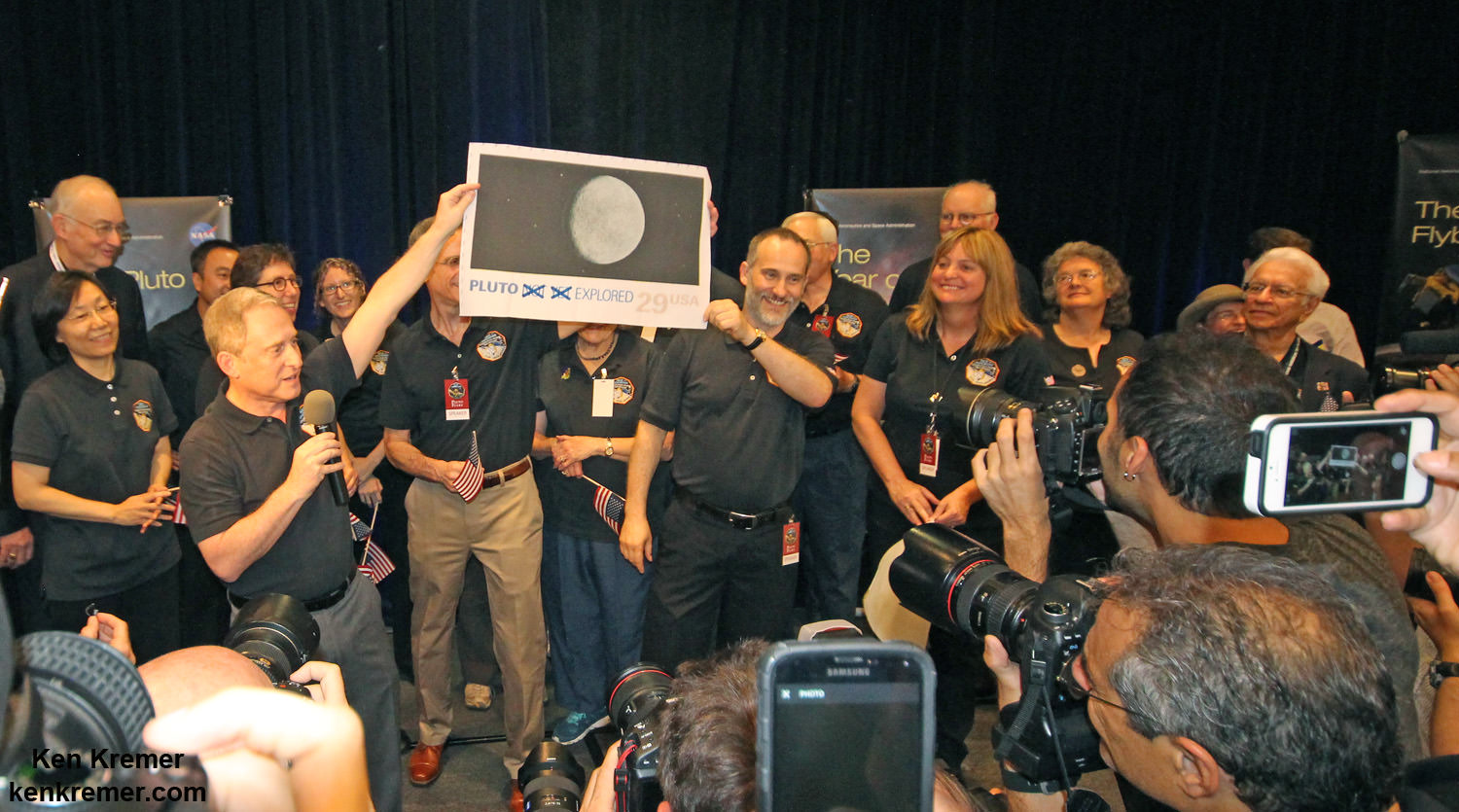
The New Horizons mission team celebrates successful flyby of Pluto in the moments after closest approach at 7:49 a.m. EDT on July 14, 2015. New Horizons Principal Investigator Alan Stern of Southwest Research Institute (SwRI), Boulder, CO., left, Johns Hopkins University Applied Physics Laboratory (APL) Director Ralph Semmel, center, and New Horizons Co-Investigator Will Grundy Lowell Observatory hold an enlarged print of an U.S. stamp with their suggested update after Pluto became the final planet in our solar system to be explored by an American space probe (crossing out the words ‘not yet’) – at the Johns Hopkins University Applied Physics Laboratory (APL) in Laurel, Maryland. Credit: Ken Kremer/kenkremer.com
A much sharper view is yet to come, because the image is heavily compressed.
“Sharper versions are anticipated when the full-fidelity data from New Horizons’ Long Range Reconnaissance Imager (LORRI) are returned to Earth,” say NASA officials.
Altogether it will take 16 months to transmit all the data collected by New Horizons at the Pluto system.
The area in the LORRI image comprises an area approximately 240 miles (390 kilometers) from top to bottom.
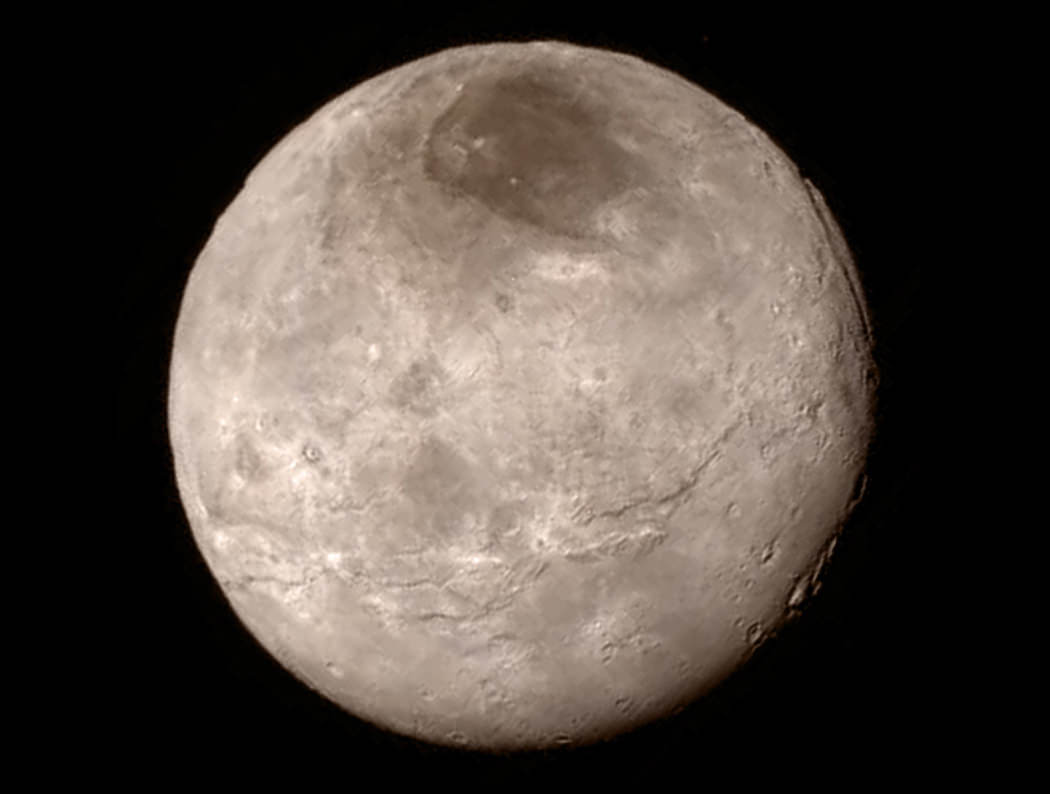
Notably there are few visible craters “indicating a relatively young surface that has been reshaped by geologic activity.”
And a “swath of cliffs and troughs stretching about 600 miles (1,000 kilometers) suggests widespread fracturing of Charon’s crust, likely the result of internal geological processes,” notes the team.
The Texas-sized moon measures about 750 miles (1200 kilometers) across, about half the diameter of Pluto. Pluto spans 1,471 miles (2,368 km) across.
After a nine year voyage through interplanetary space, New Horizons barreled past the Pluto system on Tuesday, July 14 for a history making first ever flyby at over 31,000 mph (49,600 kph), and survived the passage by swooping barely 7,750 miles (12,500 kilometers) above the planet’s amazingly diverse surface at 7:49 a.m. EDT. It passed about 17,900 miles (28,800 kilometers) from Charon during closest approach.
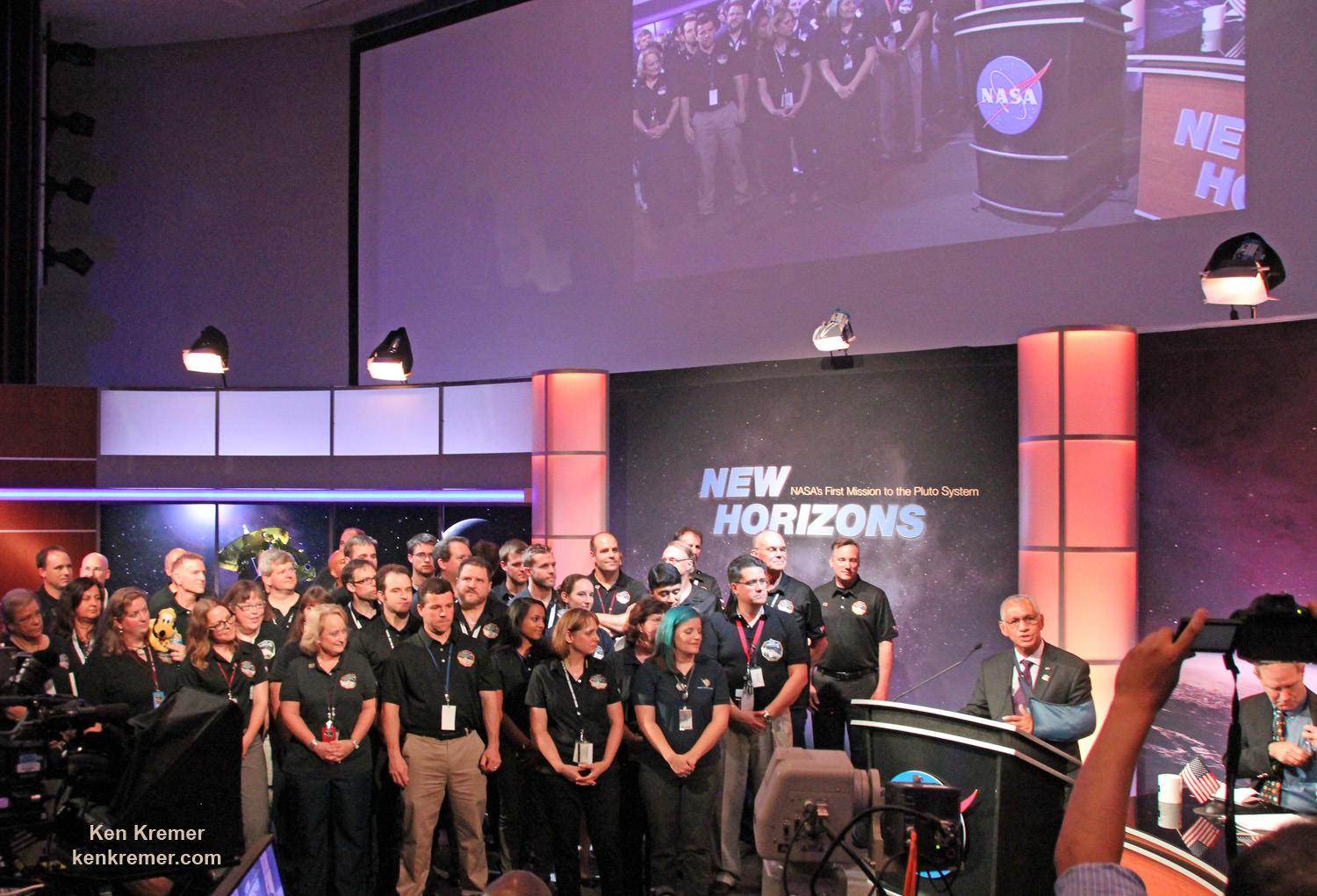
Watch for Ken’s continuing coverage of the Pluto flyby on July 14. He was onsite reporting live on the flyby and media briefing from the Johns Hopkins University Applied Physics Laboratory (APL).
New images will be released on Friday, July 17 – watch for my story.
Stay tuned here for Ken’s continuing Earth and planetary science and human spaceflight news.

NASA’s New Horizons Makes Major Discoveries: Young Ice Mountains on Pluto and Crispy Young Chasms on Charon
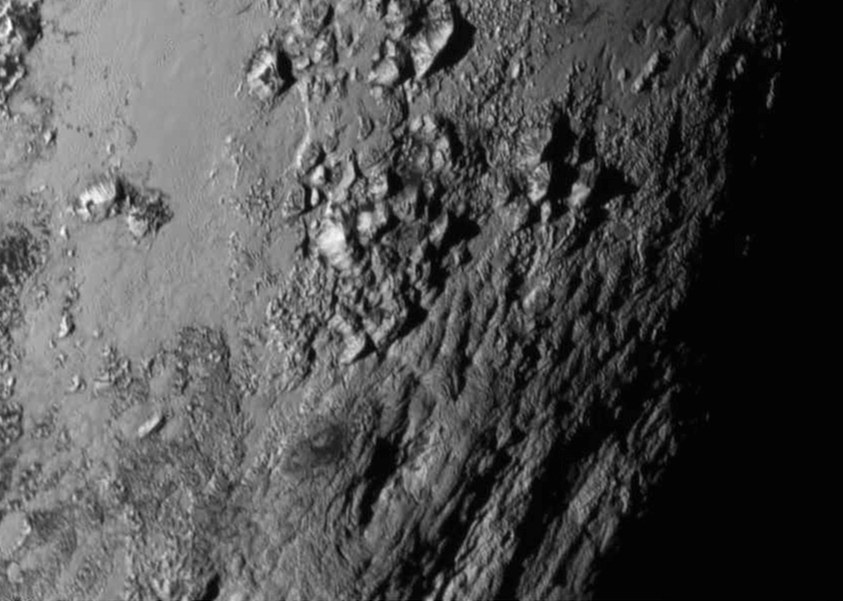
New close-up images of a region near Pluto’s equator reveal a giant surprise — a range of youthful mountains rising as high as 11,000 feet (3,500 meters) above the surface of the icy body. Credits: NASA/JHU APL/SwRI
Story/photos expanded[/caption]
APPLIED PHYSICS LABORATORY, LAUREL, MD – Scientists leading NASA’s historic New Horizons mission to the Pluto system announced the first of what is certain to be a tidal wave of new discoveries, including the totally unexpected finding of young ice mountains at Pluto and crispy clear views of young fractures on its largest moon Charon, at a NASA media briefing today (July 15) at the Applied Physics Laboratory (APL) in Laurel, Maryland.
A treasure trove of long awaited data has begun streaming back to Mission Control at Johns Hopkins University Applied Physics Laboratory to the mouth watering delight of researchers and NASA.
With the first ever flyby of Pluto, America completed the initial up close reconnaissance of the planets in our solar system. Pluto was the last unexplored planet, building on missions that exactly started 50 years ago in 1965 when Mariner IV flew past Mars.
“Pluto New Horizons is a true mission of exploration showing us why basic scientific research is so important,” said John Grunsfeld, associate administrator for NASA’s Science Mission Directorate in Washington.
“The mission has had nine years to build expectations about what we would see during closest approach to Pluto and Charon. Today, we get the first sampling of the scientific treasure collected during those critical moments, and I can tell you it dramatically surpasses those high expectations.”

Today the team announced that New Horizons has already made a totally unexpected discovery showing clear evidence of ice mountains on Pluto’s surface in the bright area informally known as the ‘big heart of Pluto.’
The new close-up image released today showed an icy mountain range near the base of the heart with peaks jutting as high as 11,000 feet (3,500 meters) above the surface, announced John Spencer, New Horizons science team co-investigator at the media briefing.
“It’s a very young surface, probably formed less than 100 million years old,’ said Spencer. “It may be active now.”
Spencer also announce that the heart shaped region will now be named “Tombaugh Reggio” in honor of Clyde Tombaugh, the American astronomer who discovered Pluto in 1930.
“We are seeing water ice.”
“I never would have imagined this!” Spencer exclaimed.
“And I’m very surprised that there are no craters in the first high resolution images.”
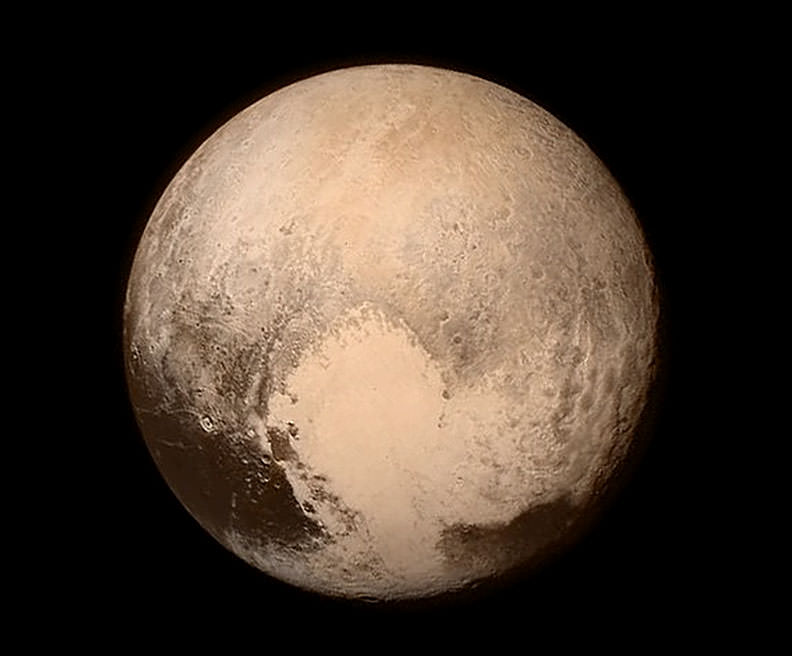
The finding of ice mountains has major scientific implications.
Unlike the icy moons of giant planets, Pluto cannot be heated by gravitational interactions with a much larger planetary body. Some other process must be generating the mountainous landscape, said the team.
“This may cause us to rethink what powers geological activity on many other icy worlds,” says Spencer of SwRI.
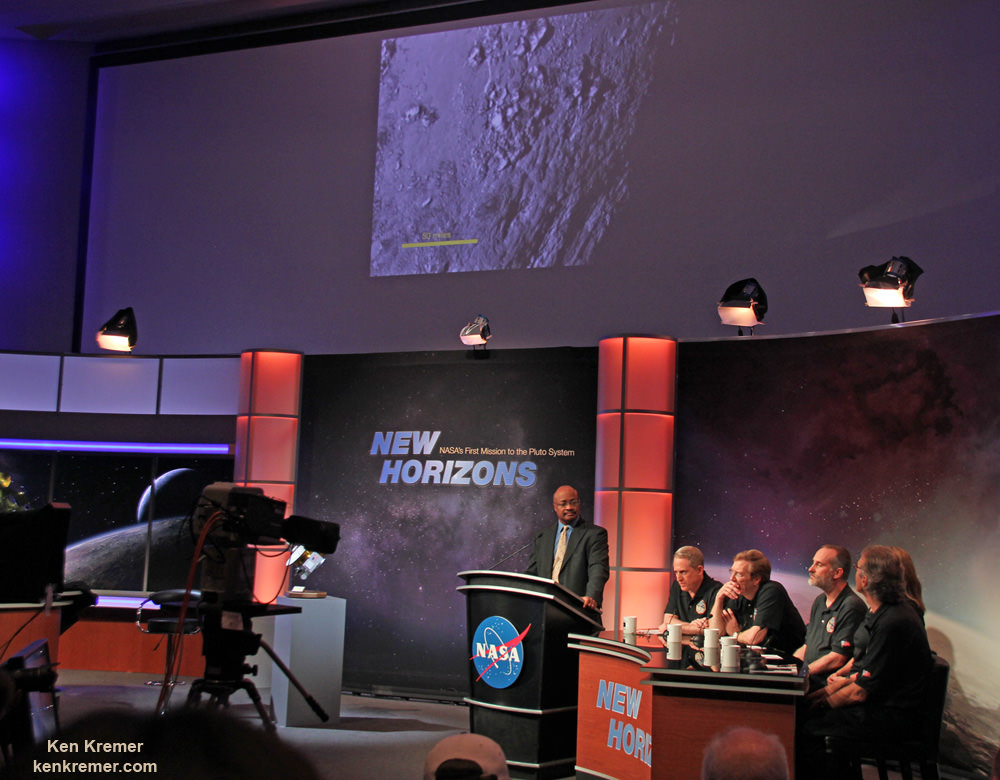
“Pluto may have internal activity. There may be geysers or cryovolcanoes,” New Horizons principal investigator Alan Stern of the Southwest Research Institute, Boulder, Colorado, said during the media briefing. However there is no evidence for them yet.
Additional high resolution images for “Tombaugh Reggio” area are being transmitted back to Earth today and will continue.
“Finding a mountain range of ice is a complete surprise,” Stern noted.
After a nine year voyage through interplanetary space, New Horizons barreled past the Pluto system on Tuesday, July 14 for a history making first ever flyby at over 31,000 mph (49,600 kph), and survived the passage by swooping barely 7,750 miles (12,500 kilometers) above the planet’s amazingly diverse surface.
The team had to wait another 12 hours for confirmation that the spacecraft lived through the daring encounter when signals were reacquired as planned at 8:53 p.m. EDT last night. Since New Horizons swung past Pluto to continue its voyage, the probe is now more than million miles outbound just 24 hours later.
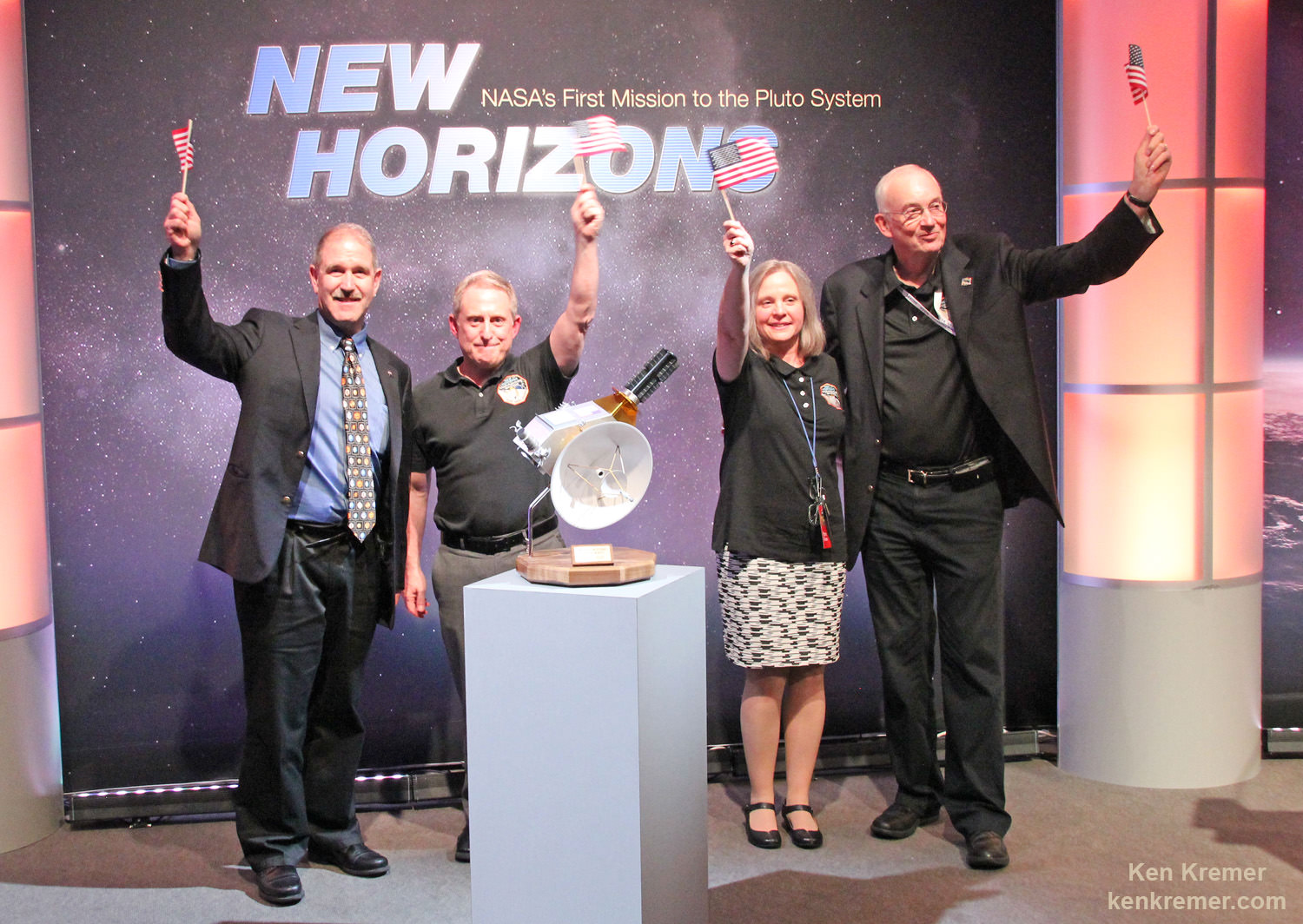
The New Frontiers spacecraft was built by a team led by Stern and included researchers from SwRI and the Johns Hopkins University Applied Physics Laboratory (APL) in Laurel, Maryland. APL also operates the New Horizons spacecraft and manages the mission.

Watch for Ken’s continuing onsite coverage of the Pluto flyby on July 14 from the Johns Hopkins University Applied Physics Laboratory (APL).
Stay tuned here for Ken’s continuing Earth and planetary science and human spaceflight news.

Big Discovery from NASA’s New Horizons; Pluto is Biggest Kuiper Belt Body

Plutophiles everywhere rejoice. On the eve of history’s first ever up close flyby of mysterious Pluto on Tuesday morning July 14 making the first detailed scientific observations, NASA’s New Horizons has made a big discovery about one of the most basic questions regarding distant Pluto. How big is it?
Measurements by New Horizons gathered just in the past few days as the spacecraft barrels towards the Pluto planetary system now confirm that Pluto is indeed the biggest object in the vast region beyond the orbit of Neptune known as the Kuiper Belt.
Pluto is thus the undisputed King of the Kuiper Belt!
Pluto measures 1,473 miles (2,370 kilometers) in diameter, which is at the higher end of the range of previous estimates.
The big news was announced today, by New Horizons principal investigator Alan Stern of the Southwest Research Institute, Boulder, Colorado, during a live media briefing at Pluto mission control at the Johns Hopkins University Applied Physics Laboratory (APL) in Laurel, Maryland.
“This settles the debate about the largest object in the Kuiper Belt,” Stern noted.
New Horizons will swoop to within about 12,500 kilometers (nearly 7,750 miles) of Pluto’s surface and about 17,900 miles (28,800 kilometers) from Charon during closest approach at approximately 7:49 a.m. EDT (11:49 UTC) on July 14.
The new and definitive measurement of Pluto’s size is based on images taken by the high resolution Long Range Reconnaissance Imager (LORRI) to make this determination.
“The size of Pluto has been debated since its discovery in 1930. We are excited to finally lay this question to rest,” said mission scientist Bill McKinnon, Washington University, St. Louis.
Pluto was the first planet discovered by an American, Clyde Tombaugh.
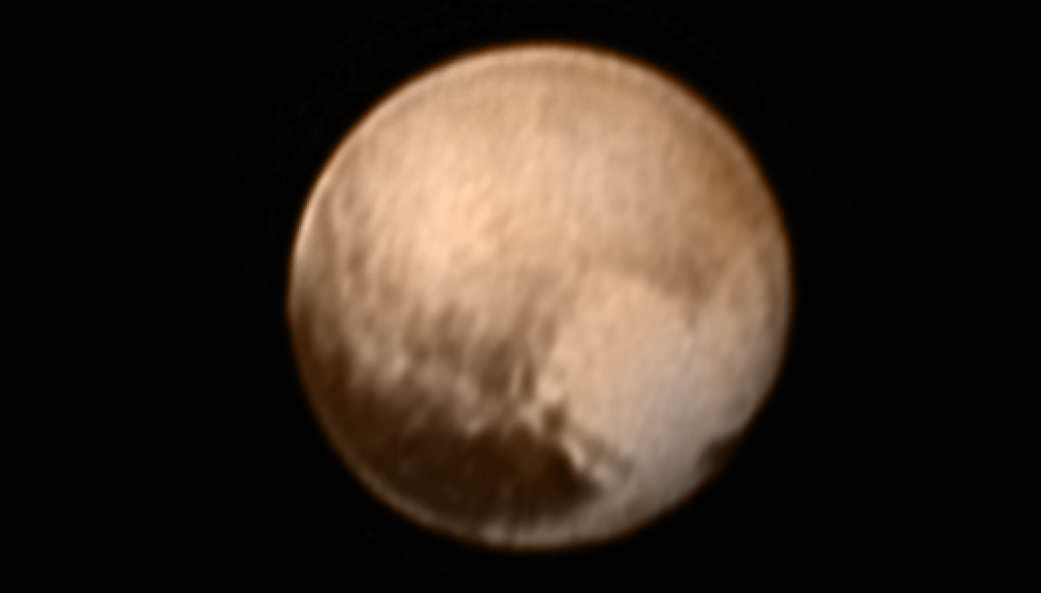
Pluto is bigger than Eris, another big Kuiper Belt object discovered in 2005 by Mike Brown of Caltech, which is much further out from the Sun than Pluto. The discovery of Eris further fueled the controversial debate about the status of Pluto’s planethood.
Eris comes in second in size in the Kuiper Belt at only 1,445 miles (2,326 km) in diameter.
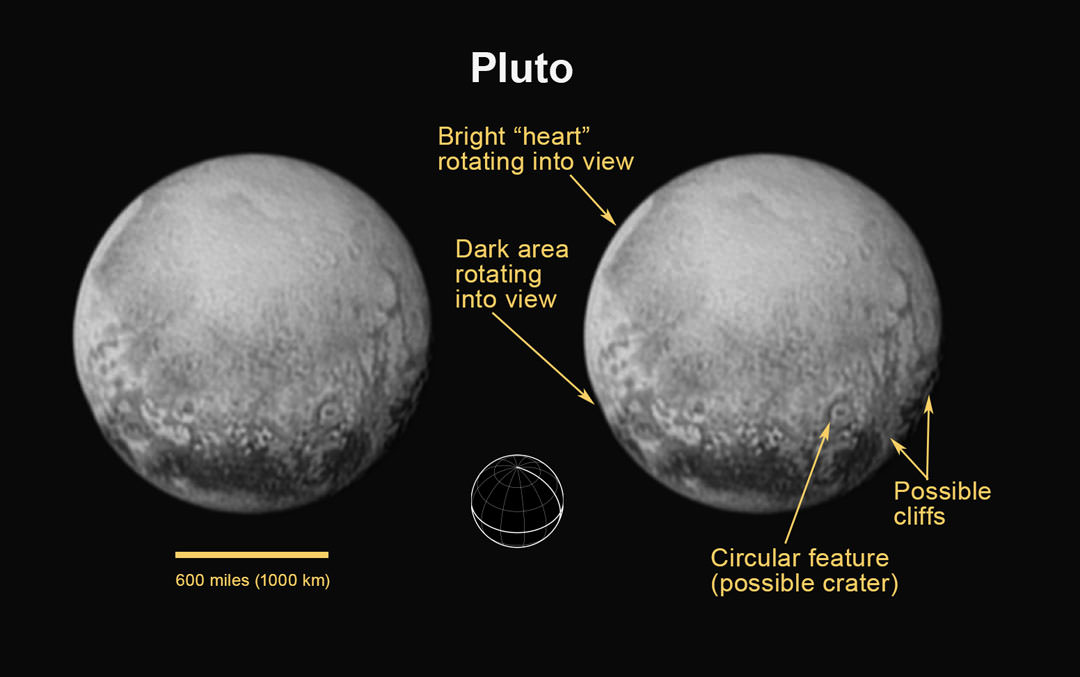
Credits: NASA/JHUAPL/SWRI
Stern also noted that because Pluto is slight bigger than the average of previous estimates, its density is slightly lower than previously thought. Therefore the fraction of ice in its interior is slightly higher and the fraction of rock is slightly lower. But further data is required to pin the density down more precisely.
The uncertainty in Pluto’s size has persisted for decades and was due to the fact that Pluto has a very tenuous atmosphere composed of nitrogen.
Furthermore Pluto’s lowest atmospheric layer called the troposphere, is shallower than previously believed.
On the other hand, its largest moon Charon with which it forms a double planet, lacks a substantial atmosphere and its size was known with near certainty based on ground-based telescopic observation.
New Horizons LORRI imagery has confirmed that Charon measures 751 miles (1208 km) kilometers) across.
Stern also confirmed that frigid Pluto also has a polar cap composed of methane and nitrogen ices based on measurements from the Alice instrument.
LORRI has also zoomed in on two of Pluto’s smaller moons, Nix and Hydra.
“We knew from the time we designed our flyby that we would only be able to study the small moons in detail for just a few days before closest approach,” said Stern. “Now, deep inside Pluto’s sphere of influence, that time has come.”
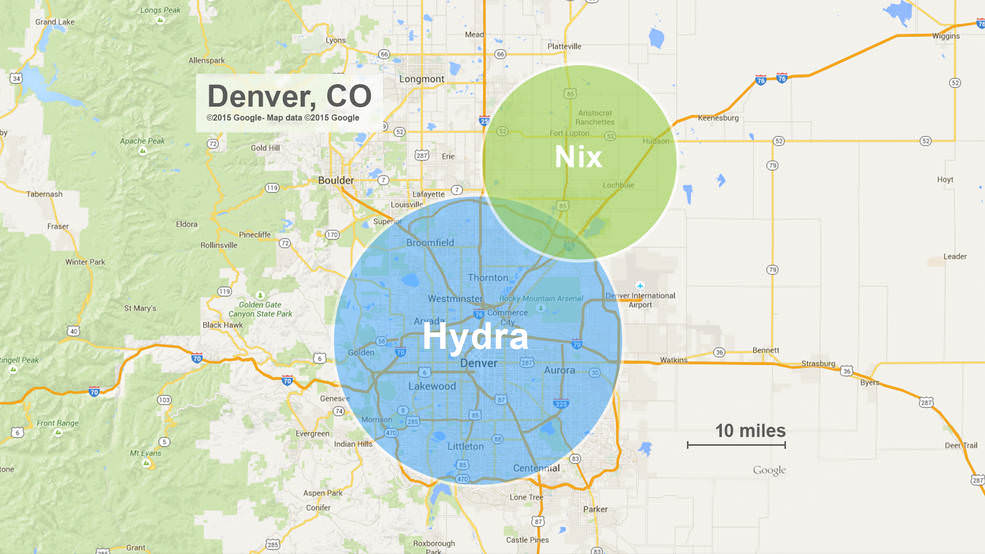
But because they are so small, accurate measurement with LORRI could only be made in the final week prior to the July 14 flyby.
Nix is estimated to be about 20 miles (about 35 kilometers) across, while Hydra is roughly 30 miles (roughly 45 kilometers) across. These sizes lead mission scientists to conclude that their surfaces are quite bright, possibly due to the presence of ice.
Determinations about Pluto’s two smallest moons, Kerberos and Styx, will be made later at some point during the 16-month long playback of data after the July 14 encounter.
It has been three decades since we last visited planetary bodies at the outer reaches of our solar system when Voyager 2 flew past Uranus and Neptune in 1986 and 1989.

New Horizons is closing in fast on its quarry at a whopping 31,000 mph (49,600 kph) after a nine year interplanetary voyage and is now less than half a million miles away, in the final hours before closest approach.
The New Frontiers spacecraft was built by a team led by Stern and included researchers from SwRI and the Johns Hopkins University Applied Physics Laboratory (APL) in Laurel, Maryland. APL also operates the New Horizons spacecraft and manages the mission.
Watch for Ken’s continuing onsite coverage of the Pluto flyby on July 14 from the Johns Hopkins University Applied Physics Laboratory (APL).
Stay tuned here for Ken’s continuing Earth and planetary science and human spaceflight news.
Charon Up Close Reveals Colossal Chasms and Craters: 1 Day and 1 Million Miles Out from Pluto Flyby

Chasms, craters, and a dark north polar region are revealed in this image of Pluto’s largest moon Charon taken by New Horizons on July 11, 2015. The annotated version includes a diagram showing Charon’s north pole, equator, and central meridian, with the features highlighted. Credits: NASA/JHUAPL/SWRI
Story/imagery updated[/caption]
In the final days before humankinds first ever flyby of mysterious and tantalizing Pluto for the history making up close visit on Tuesday, July 14, NASA’s New Horizons spacecraft has just delivered the sharpest and most stunning view yet of its binary companion Charon – and unveiled it to be a geologically rich world with colossal chasms, a multitude of craters and a humongous dark splotch in the northern regions. It’s obviously quite different in appearance and varies in composition from its larger planetary host.
Indeed the largest of Charon’s chasms stretches farther than Earth’s Grand Canyon. And it’s taken New Horizons over nine years speeding through space – since launching back in 2006 as the fastest spacecraft departing Earth – to get close enough to see these wonders for the first time.
“The most pronounced chasm, which lies in the southern hemisphere, is longer and miles deeper than Earth’s Grand Canyon,” says William McKinnon, deputy lead scientist with New Horizon’s Geology and Geophysics investigation team, in a NASA statement.
To put that into perspective, consider this; Charon is only about 750 miles (1200 kilometers) across, about half the diameter of Pluto. The Grand Canyon stretches 277 miles (446 km) across the western United States and is up to 18 miles (29 km) wide and attains a depth of over a mile (6093 feet or 1857 meters). Thus Charon’s ‘Grand Canyon’ is truly gargantuan in comparison to its moons size when compared to our Grand Canyon.
At 1471 miles (2368 km) across, Pluto is about half the diameter of the United States. Both Pluto and Charon and largely composed of icy materials, with much less rock compared to the terrestrial planets like Earth.
“This is the first clear evidence of faulting and surface disruption on Charon,” says McKinnon, who is based at the Washington University in St. Louis.
“New Horizons has transformed our view of this distant moon from a nearly featureless ball of ice to a world displaying all kinds of geologic activity.”
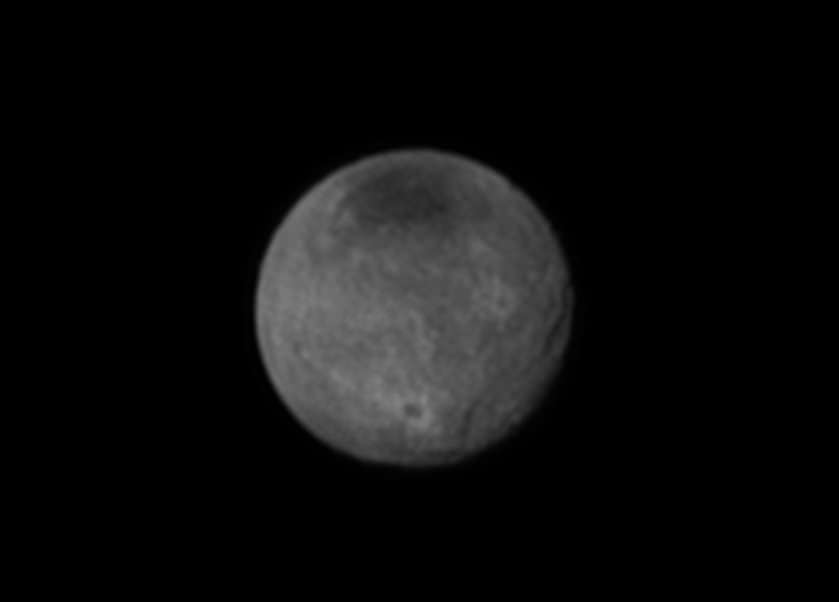
The exquisite new image of Charon’s chasms and canyons was just released by NASA this evening, Sunday, July 12. It was taken yesterday, Saturday, July 11, by New Horizons Long Range Reconnaissance Imager (LORRI) at a distance of 2.5 million miles (4 million kilometers) from Pluto and Charon, and radioed back to Earth today.
The largest crater seen in the July 11 images lies near Charon’s south pole and is about 60 miles (96.5 kilometers) across.
“The brightness of the rays of material blasted out of the crater suggest it formed relatively recently in geologic terms, during a collision with a small body some time in the last billion million years,” says the team.
“The darkness of the crater’s floor is especially intriguing,” says McKinnon.
“One explanation is that the crater has exposed a different type of icy material than the more reflective ices that lie on the surface. Another possibility is that the ice in the crater floor is the same material as its surroundings but has a larger ice grain size, which reflects less sunlight. In this scenario, the impactor that gouged the crater melted the ice in the crater floor, which then refroze into larger grains.”
New Horizons is now merely one day and one million miles (1.6 million km) out from its history making encounter with the Pluto planetary system – some three billion miles (4.8 billion km) from Earth. It passed the million mile milestone at 11:23 p.m. EDT, Sunday night July 12.
And its closing in fast on its quarry at a whopping 31,000 mph (49,600 kph) after a nine year interplanetary voyage.
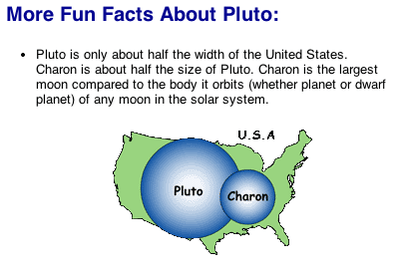
The high resolution LORRI imager is achieving an image resolution of 5 mile per pixel at this moment at a million miles away. And it will gets thousands of times better during the closest approach.
“Features as small as the lakes in New York’s Central Park and wharfs on the Hudson will be resolved,” said New Horizons principal investigator Alan Stern of the Southwest Research Institute, Boulder, Colorado, during a live mission update today, July 12. The image resolution will reach a maximum of about 230 feet (70 meters).
New Horizons suite of seven science instruments will collected 44 gigabits of data during the flyby encounter period lasting from July 7 to July 16, from Pluto, Charon and the four tiny moons – Hydra, Styx, Nix and Kerberos.
New Horizons will swoop to within about 12,500 kilometers (nearly 7,750 miles) of Pluto’s surface and about 17,900 miles (28,800 kilometers) from Charon during closest approach at approximately 7:49 a.m. EDT (11:49 UTC) on July 14.
Pluto and Charon are gravitationally locked with an orbital period of 6.4 days, so they always show the same face to one another. They orbit about 12,160 mi (19,570 kilometers) apart but about a center of gravity, or barycenter, above the surface of Pluto, unlike any of the other major bodies in our solar system.
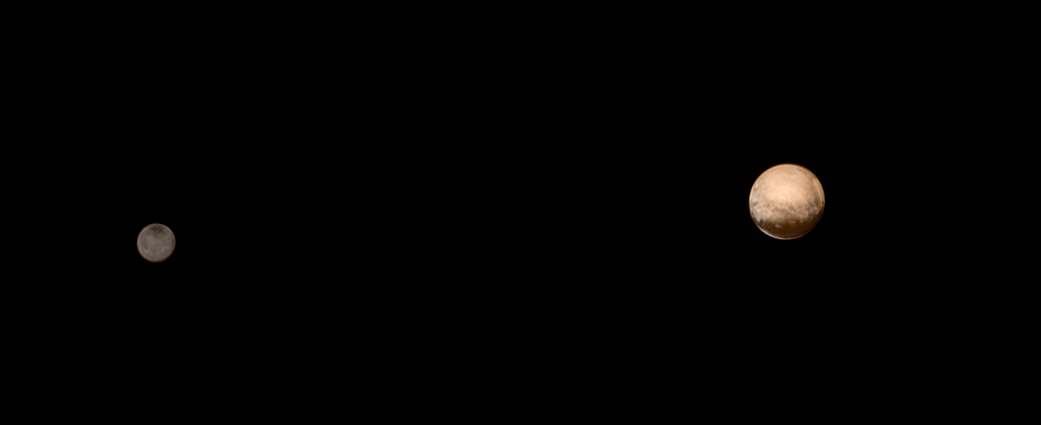
Charon is by far the largest of Pluto’s five moons. The new July 11 image also shows that it sports a “mysterious dark region” stretching some 200 miles across near the north pole.
Pluto is the last of the nine classical planets to be explored up close and completes the initial the initial reconnaissance of the solar system nearly six decades after the dawn of the space age. It represents a whole new class of objects known as the ice dwarfs, located in the Kuiper Belt – a relic of solar system formation replete with countless bodies.
It has been three decades since we last visited planetary bodies at the outer reaches of our solar system when Voyager 2 flew past Uranus and Neptune in 1986 and 1989.
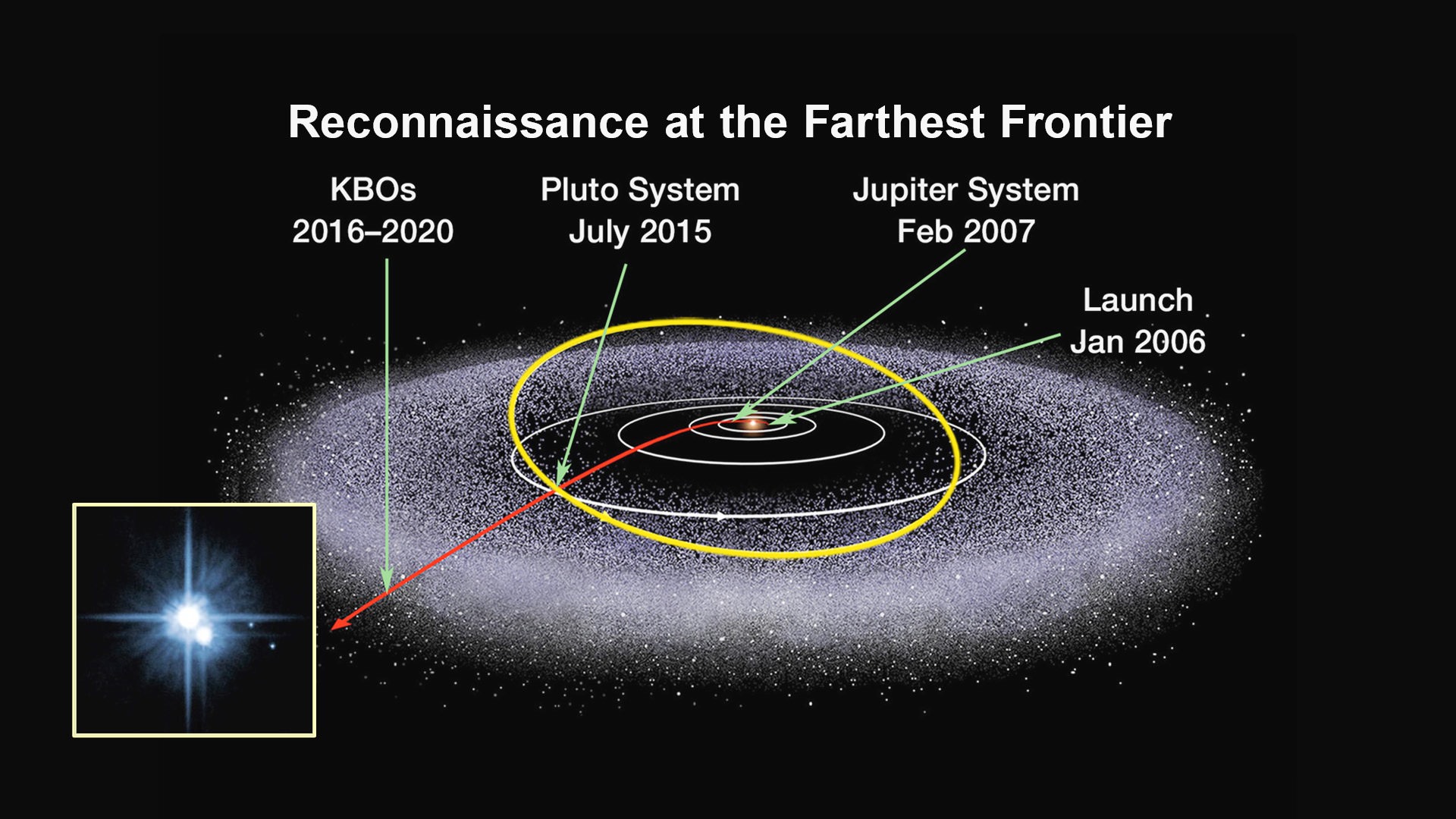
The New Frontiers spacecraft was built by a team led by Stern and included researchers from SwRI and the Johns Hopkins University Applied Physics Laboratory (APL) in Laurel, Maryland. APL also operates the New Horizons spacecraft and manages the mission.
Watch for Ken’s continuing onsite coverage of the Pluto flyby on July 14 from the Johns Hopkins University Applied Physics Laboratory (APL).
Stay tuned here for Ken’s continuing Earth and planetary science and human spaceflight news.

